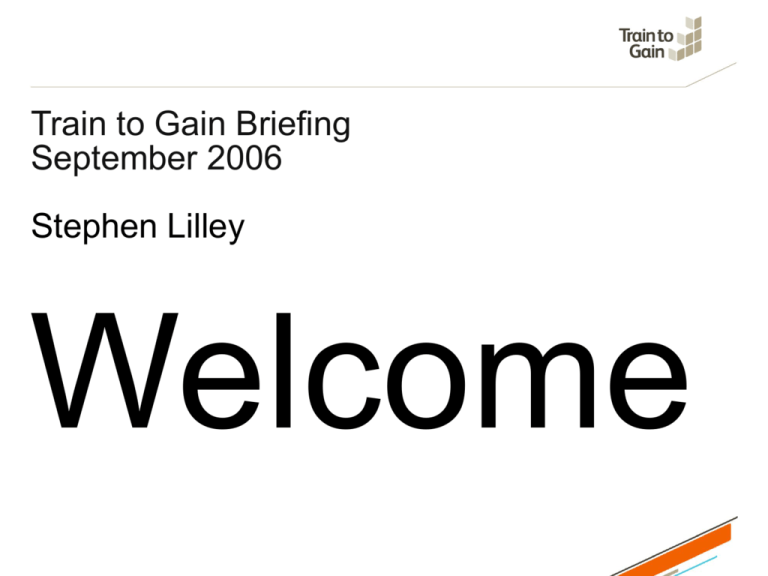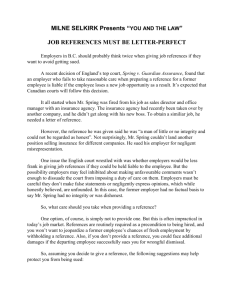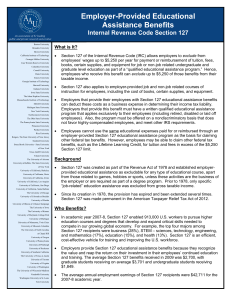Sub-Contractors Lead Contractor - Institute of the Motor Industry
advertisement

Train to Gain Briefing September 2006 Stephen Lilley Welcome OVERVIEW WHAT IS TRAIN TO GAIN? – “Train to Gain is a new service to help businesses across England get the training they need to succeed and stay successful. “ • The new Train to Gain service consists of two principle elements: • Skills Brokerage – provided by impartial and independent brokers helping employers identify all training needs and appropriate training providers. • Flexible and responsive training Provision – delivered by training providers who have demonstrated through a procurement process and on-going performance that they can deliver high quality, employer–focused training. WHAT IS TRAIN TO GAIN? • Train to Gain provision marks a new way of working with employers. It will be: • Employer-focused and led. • Delivered to meet employers’ needs and fit with their business demands. • Flexible and responsive. • High quality. Core Offer • The core Train to Gain offer will comprise: • Support from a broker working to national standards and linked to a reformed business support service • Access to LSC funded programmes: Skills for Life, first NVQ level 2 qualifications and Apprenticeships • Information and advice to employees on qualifications and training Additional elements • Flexible elements of the Train to Gain service could include: • Support for leadership and management training • Support for higher level training and other training packages • Bespoke training packages paid for by employers • Investors in People • Level 3 skills in particular Level 3 Trial BROKERAGE Integrating Brokerage: Key aims & principles • Realise the vision in “Skills: Getting on in business, getting on at work” and integrate the range of business support services and skills brokerage • Use brokers working towards a national standard • Be impartial and easy to access SKILLS BROKERAGE • 3 Key Performance Indicators: – Number of Employers Engaged - focus on Hard to Reach – Customer Satisfaction – Skill Brokers achieving new standard PROVISION BACKGROUND • Train to Gain Business Objectives & Targets • 33,000 employers in 2006/07 • 53,000 employers in 2007/08 • Financial Year Learners First Full L2 • 2006/7 233,649 45,616 • 2007/08 371,124 141,826 • 2008/09 361,751 178,295 • 2009/10 361,536 173,242 1,328,060 538,979 • 4 Year Totals NATIONAL OVERVIEW FUNDING AND ELIGIBILITY • There are three types of funding supporting Train to Gain provision at first full Level 2 and Skills for Life • Type A – Mainstream funding used to deliver “Train to Gain like” activity. This will be agreed with providers at local LSC level • Type B – Planned but subject to employer choice, available from the discrete Train to Gain budget • Type C – Rapid Response for the discrete Train to Gain budget. TRAIN TO GAIN FUNDING • Planned but subject to employer choice: • 80% of the budget allocated to fund Skills for Life and First NVQ Level 2 qualifications • payment profile 50% on start and 50% on completion (change from ETP 20 / 30/ 50) • Responsive: • 20% of the budget retained by region to respond to employer demands throughout the year • payment profile 50% on start and 50% on completion NATIONAL OVERVIEW FUNDING RATES Sector Subject - First Full Level Two Higher Lower Health, Public Services and Care £1500 £750 Agriculture, Horticulture and Animal Care £1500 £750 Engineering and Manufacturing Technologies £1800 £900 Construction, Planning and the Built Environment £1800 £900 Information and Communication Technology £1200 £600 Retail and Commercial Enterprise £1200 £600 Transportation £1800 £900 Hair and Beauty £1500 £750 Hospitality £1200 £600 Leisure, Travel and Tourism £1200 £600 Business, Administration and Law £1200 £600 Skills for Life - one rate only £720 NATIONAL OVERVIEW FUNDING RATES Level two funding rates Activities covered by funding rate Higher Lower Information, Advice and Guidance Individual training needs analysis including Skills for Life Underpinning knowledge and understanding Support and assessment Contribution to Wage Costs • Employers with 1-49 employees • Sole Traders are not entitled to a contribution to wage cost • Minimum £5 per hour or actual hourly wage depending on employer choice • Up to a maximum of 70 hours • Employer gets paid when learner achieves • Payments are made to the employer through National Office • Specific responsibilities for brokers, employers and providers What will success look like? (1) • Employers • More employers effectively engaging in workforce development in order to improve productivity and effectiveness • Employers who are better informed purchasers • Employers prepared to seek external advice and assistance in order to identify solutions to their business needs • Employers who are more satisfied with the support available both brokerage and provision What will success look like? (2) • Skills Brokerage • A skills brokerage service which: • is fully integrated with a wider business support brokerage service • is impartial and independent accessible by all employers • helps employers to identify and source solutions to meet their needs • helps make employers better informed purchasers • operates on a ‘no wrong door’ principle • identifies and brokers in solutions which may or may not be publicly funded • continuously improves What will success look like? (3) • Training Providers • Provision which is relevant, responsive and flexible- both in terms of what is delivered and how • Marketing and communication to employers in an approachable language and style • A broad range of provision available to meet employer needs from Skills for Life to higher level, qualification bearing or otherwise, customised • No wrong Door approach, recognising benefit of brokerage service • Delivering against government priorities and in a way that meets employer needs • Engaging with more employers and employees resulting in higher achievement rates Train to Gain • Questions?






